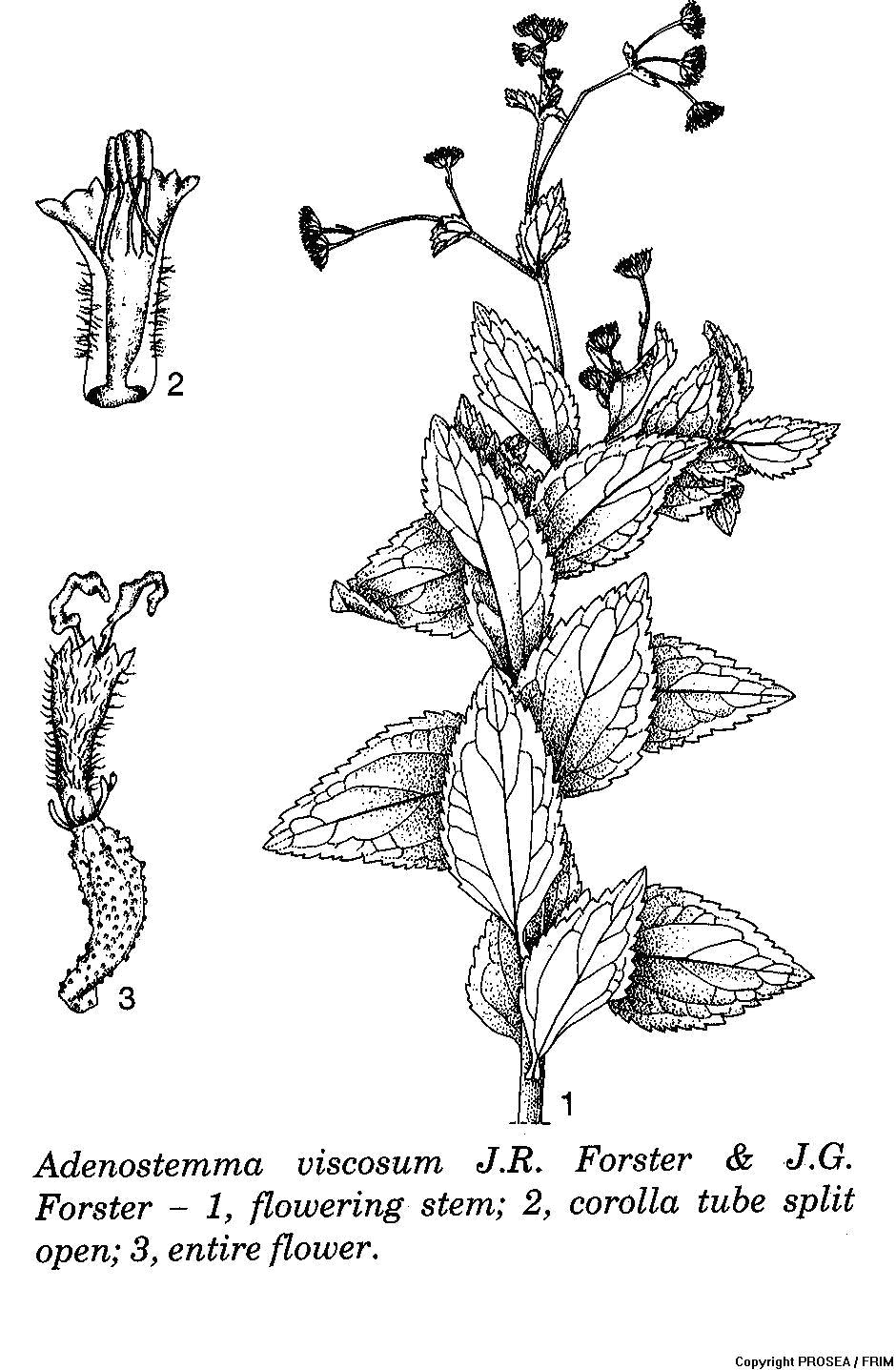Scientific Name
Adenostemma viscosum J.R.Forst. & G.Forst.
Synonyms
Adenostemma dregei DC., Adenostemma glutinosum DC., Adenostemma macrophyllum (Blume) DC., Adenostemma microcephalum DC., Adenostemma natalense DC., Adenostemma ovatum Miq., Adenostemma parviflorum (Blume) DC., Adenostemma perrottetii DC., Ageratum strictum Sims, Ethulia aquatica Roxb. ex DC., Lavenia glutinosa Gaudich., Lavenia macrophylla Blume, Lavenia parviflora Blume, Lavenia viscida Buch.-Ham. [1]
Vernacular Name
| Malaysia | Rumput tahi babi, daun susu babi, rumput pasir [2] |
| English | Dung weed [2] |
| Indonesia | Legetan warak (Javanese); rumput babi (Malay, Jakarta); udu tai (Kenyah Dayak, Kalimantan) [2] |
| Thailand | Yieo muu (Chiang Mai) [2] |
| Philippines | Boton (Tagalog) [2] |
| Vietnam | C[us]c tr[aws]ng, c[or] m[ij]eh, c[us]c d[is]nk [2] |
| Papua New Guinea | Tigtoni (Pala, Bismarck Archipelago); pisirokot (Lamekot, Bismarck Archipelago) [2] |
Geographical Distributions
Adenostemma viscosum is distributed in Pakistan, India, Japan, Southeast Asia, Australia, the Pacific Islands Tropical Africa. [2]
Botanical Description
A. viscosum is a member of the Compositae family. It is an annual or sometimes perennial herb that can reach a height of between 30-100 cm and often rooting at the lower nodes. The branch is sparse smooth but covered with soft hair. [2]
The leaves form is simple where the lower leaves are opposite while the upper ones are alternate. The leaves form is broad elliptical to oblong and broadly egg-shaped and measure about 4-20 cm x 3-12 cm. The leaves base is rounded-cuneate, the apex is acute to obtuse and margins are dentate to serrate. The leaf stalk size of the lower leaves is up to 9 cm long while the upper leaves are almost stalkless. There are no stipules. [2]
The inflorescence is consisting of heads in a lax terminal paniculate corymb. The inflorescence stalk measures 1-4 cm long. The ring of its bracts is shaped like a bell or cup-shaped, it has 2-seriate, scales sub-equal, herbaceous, and more or less connate at the base. The glandular head is measures about 3-7 mm x 6-10 mm that about 30-flowered. The flowers are all tubular with petals about 1.5-2 mm long and divided into 4, on the outside with glandular hairs in white or violet. It has 5 stamens with the ovary at the inferior of it style bifid; its branches are slender and long, thickened at the top. [2]
The fruit is small, obovate-oblong in shape, irregularly triangular with measures about 2.5-4 mm x 1 mm. It is glandular when young but afterwards smooth or warty and crowned with a pappus consisting of a few clavate setae which usually thickened at the top and glandular. The seedling is with epigeal germination. [2]
Cultivation
A. viscosum is found in open, disturbed sites and wet places along streams, in forests, thickets, and along roadsides, from sea-level to 2100 m altitude. In Pakistan, it is a vigorous monsoon weed with a rich seed production. The sticky knobs of the pappus in combination with the more convex older receptacles of Adenostemma seem particularly suited for animal dispersal, which apparently accounts for the great distributional success of the genus. [2]
Chemical Constituent
A. viscosum has been reported to contain 11-Hydroxylated kauranic acids, viz, ent-11α-hydroxy-15 α -acetoxykaur-16-en-19-oic acid, ent-11α, 15 α -dihydroxykaur-16-en-19-oic acid, (l6R)-ent-11α -hydroxy-15-oxokauran-19-oic acid and ent-11α -hydroxy-15-oxokaur-16-en-10-oic acid and their glycosides. [3]
Plant Part Used
Whole plant, leaves, roots. [2]
Traditional Use
In Malaysia the A. viscosum leaves are boiled and rubbed on the skin to relieve itch and treat infected sores, and the whole body is rubbed in case of fever. In Sabah, the leaf extract is given to prevent infections after childbirth. The leaves are chewed against dysentery, or together with those of Centella asiatica (L.) Urb. and Phyllanthus urinaria L. against colic. The leaves are used as a lotion in Indonesia to arrest baldness while leaves paste is used to poultice sun-burned skin, scorched and are applied to boils and ulcers to ripen them. The leaves are also used for treating palpitations, dysuria, toothache, aphthae and sore throats. In Bali, the A. viscosum leaves are eaten as a vegetable, but always in combination with other vegetables, because of their bitterness. [2] The leaves are also applied to hair during washing to prevent hair falls. The leaves are taken with some salt for sore throat. [4]
In Peninsular Malaysia, a decoction of the A. viscosum root is traditionally used for stomachache. In Indonesia, the roots are chewed alone or together with Piper betle leaves and ginger to treat cough. [2] The roots are also chewed with a little areca nut and some lime to treat coughs. [4]
The whole plant is used in Taiwan to treat lung congestion, pneumonia, oedema and inflammation, while in the Bismarck Archipelago the stems and leaves are used as an antiscorbutic. [2]
A. viscosum is also used in the preparation of indigo dye. [5]
Preclinical Data
No documentation.
Clinical Data
No documentation.
Poisonous Management
No documentation.
Line Drawing

References
- The Plant List. Ver1.1. Adenostemma viscosum J.R.Forst. & G.Forst. [homepage on the Internet]. c2013 [updated 2012 Feb 11; cited 2016 May 25]. Available from: http://www.theplantlist.org/tpl1.1/record/gcc-46201
- Schmelzer GH. Adenostemma viscosum J.R. Forster & J.G. Forster In: van Valkenburg JLCH, Bunyapraphatsara N, editors. Plant resources of South-East Asia No. 12(2): Medicinal and poisonous plants 2. Leiden, Netherlands: Backhuys Publishers, 2001; p. 43-45.
- Cheng PC, Hufford CD, Doorenbos NJ. Isolation of 11-hydroxylated Kauranic acids from Adenostemma lavenia. J Nat Prod. 1979;42(2):183-186.
- Heyne K. Tumbuhan berguna Indonesia. Jilid I. Balai Litbang Kehutanan, Departemen Kehutanan, 1987; p. 312–314, 518, 538–539,.
- Cooksey CJ. Indigo: an annotated bibliography. Biotech Histochem. 2007;82(2):105-125.


